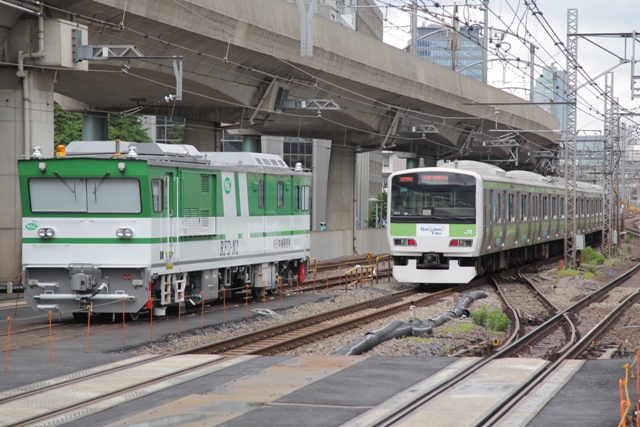
RFD-N2 vehicle (left) and the EMU JR East 231-500 series (right)
I take the JR East Chuo Line to go to my office. My exit station is Tokyo, which is one of the largest terminals in Japan. While walking around the station, I am likely to encounter a special vehicle standing on a siding nearby the Yamanote Line track. What is it?
It is a rail flaw detection (RFD) vehicle of Japan Railway Track Consultants Company (NSG). According to NSG's website, wear, fatigue and corrosion of rails develop day by day through the repeated running of trains, depending on the environmental conditions of the places where the tracks are laid. A tiny flaw on the rail surface caused by fatigue gradually gets bigger and might lead to breakage. A problem with rails affects the train service. It is very important to identify any flaws inside the rail that are not visible on the exterior.
The RFD vehicle is equipped with the latest flaw detection system to identify any rail flaws and measure the wear of rail tops, contributing to accident prevention. Specifically, RFD-N2 flaw-detection vehicle, which was introduced in 2011, has a rail-top image monitoring system.
Unfortunately, I have never seen firsthand the RFD-N2 running on the track. It is probably operated in the middle of the night, after the last train. I don't know whether RFD-N2 is self-propelled or not; but at least I can't identify any pantographs on the roof. I will report again if I found out the data.
It is a rail flaw detection (RFD) vehicle of Japan Railway Track Consultants Company (NSG). According to NSG's website, wear, fatigue and corrosion of rails develop day by day through the repeated running of trains, depending on the environmental conditions of the places where the tracks are laid. A tiny flaw on the rail surface caused by fatigue gradually gets bigger and might lead to breakage. A problem with rails affects the train service. It is very important to identify any flaws inside the rail that are not visible on the exterior.
The RFD vehicle is equipped with the latest flaw detection system to identify any rail flaws and measure the wear of rail tops, contributing to accident prevention. Specifically, RFD-N2 flaw-detection vehicle, which was introduced in 2011, has a rail-top image monitoring system.
Unfortunately, I have never seen firsthand the RFD-N2 running on the track. It is probably operated in the middle of the night, after the last train. I don't know whether RFD-N2 is self-propelled or not; but at least I can't identify any pantographs on the roof. I will report again if I found out the data.
Side view of RFD-N2 vehicle
More information about the inspection vehicles: